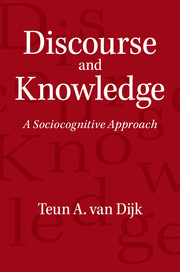Book contents
- Frontmatter
- Contents
- List of figures
- List of tables
- Acknowledgment
- 1 Introduction
- 2 Elements of a theory of natural knowledge
- 3 Discourse, knowledge and cognition
- 4 Discourse, knowledge and social cognition
- 5 Discourse, knowledge and society
- 6 Discourse, knowledge and culture
- 7 Language, discourse and knowledge
- 8 Conclusions
- References
- Index
2 - Elements of a theory of natural knowledge
Published online by Cambridge University Press: 05 August 2014
- Frontmatter
- Contents
- List of figures
- List of tables
- Acknowledgment
- 1 Introduction
- 2 Elements of a theory of natural knowledge
- 3 Discourse, knowledge and cognition
- 4 Discourse, knowledge and social cognition
- 5 Discourse, knowledge and society
- 6 Discourse, knowledge and culture
- 7 Language, discourse and knowledge
- 8 Conclusions
- References
- Index
Summary
Introduction
Eleven years ago, on March 8, 2003, Tony Blair, then Prime Minister of Great Britain, introduced and then defended a motion in the House of Commons urging the Members of Parliament to, among other things,
(1) support(s) the decision of Her Majesty’s Government that the United Kingdom should use all means necessary to ensure the disarmament of Iraq’s weapons of mass destruction; offers wholehearted support to the men and women of Her Majesty’s Armed Forces now on duty in the Middle East.
After a debate of many hours, with the support of the Conservative Opposition, but against the position of many Labour and Liberal Members of Parliament (MPs), and defying huge public protests, British parliament voted to go to war against Iraq – as did the conservative governments in the USA and Spain, led by George W. Bush and José María Aznar, respectively. Defending his motion, and according to the official record in Hansard, Blair argued:
(2) It is that, with history, we know what happened. We can look back and say, “There’s the time; that was the moment; that’s when we should have acted.”
After a decade, we now know the consequences of that parliamentary decision and the ensuing war. Using his very words, we now also know “with history” that what Tony Blair in his motion presupposed to be true, namely that Iraq had weapons of mass destruction (WMDs) – a main reason to go to war, as the motion suggests – turned out to be false. Does this mean that Tony Blair lied in his motion? Or was he simply mistaken and ill-informed by the security services of the UK and the USA?
- Type
- Chapter
- Information
- Discourse and KnowledgeA Sociocognitive Approach, pp. 14 - 44Publisher: Cambridge University PressPrint publication year: 2014



